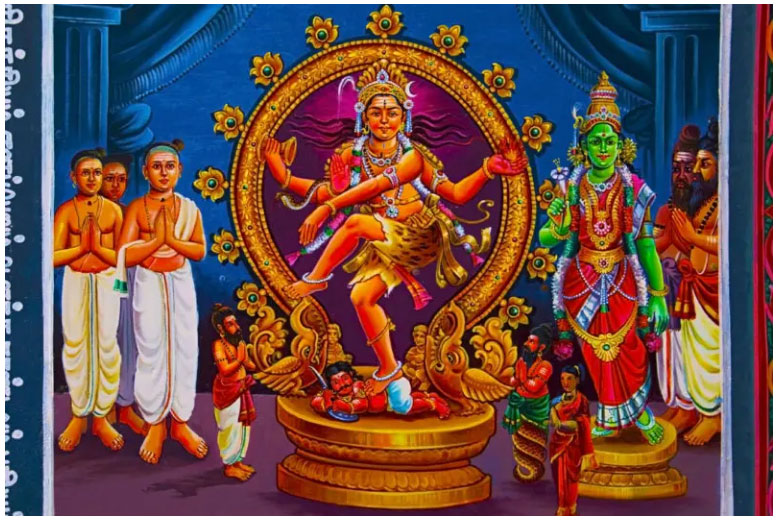Om Namah Shivaya
It is difficult to imagine a more emblematic or identifiable mantra in India than Om Namah Shivaya. It is dedicated to Lord Shiva and is mentioned in Yajurveda in the hymn Shri Rudram. This mantra dates back literally thousands of years and is the most important form of devotion to the Shaivist sect of Hinduism. Om Namah Shivaya is a beautiful prayer and a beloved mantra that can be sung or recited.
A bit of history
Shaivism is a sect that believes that Shiva is the most important Hindu god, in fact the only relevant one. This has influenced many other sects in India, as Shaivism is very influential and ancient; it dates back 2500 years and is considered one of the oldest forms of Hinduism.
Shiva is the most widely recognized god of destruction.
But according to the sect of Shivaism, he is the creator (considered as Brahma), the preserver (considered as Vishnu) and the destructive force of the universe. Of course, as in Hinduism, there are many schools of thought within Shaivaism, but all of them practice the sacred chant Om Namah Shivaya.
According to the texts, this chant confers deep spiritual experiences and even benefits (supernatural gifts) when practiced deeply and correctly.
The meaning of Om Namah Shivaya
Om namah shivaya is composed of three prayers and the meaning of this chant is relatively simple:
• The first word Om is the word "Om" it is considered to constitute the divine in the form of sound. Before the universe existed, it was empty of all pure existence and without vibrations. From this emptiness was born the vibration, which is called Om. Then, slowly, the creation of the universe began. It can also be written "aum", which offers deference to those aspects of the triad of God that are perceived in Hinduism: the creator, the maintainer and the destroyer. This is particularly interesting since this mantra is addressed directly to Shiva. "Om" appears at the beginning of almost all prayers and invocations in Sanskrit.
• Namah: Literally, it means to bow or worship. This word can be pronounced as nama or namaha. It depends on the number of syllables needed in the sentence. In this case, it is simply pronounced in a breathing way, and the "ha" is not fully pronounced. This allows the mantra to flow properly.
• Shivaya: Shiva or the inner self. The "aya" at the end of the word Shiva means "to" or "for". Therefore, in this sentence, the greetings are to Shiva.
In the tradition of Shaivism Siddha (it is an initiation mantra) and Shaiva Siddhanta Shaivism, Namah Shivaya is considered the Pancha Bodha Tatva of Lord Shiva and his universal unity of five elements:
• Na : Earth
• Mah : Water
• Shi : Fire
• Go: Air
• Ya : Sky or ether
This means that "the universal consciousness is one". These five components manifest the absolute of the universe according to Hindu philosophy. When it is well understood (and according to Shaivism), it means "I bow before the inner self".
The "NA" falls into the first chakra, the place of foundation that embodies the earth and solidity. It has a lot to do with issues of emotional survival, the right to belong and to have. It is located at the base of the spine, between the anus and the genitals.
The "MA" rises to the second chakra, represented by the water element and issues of sexuality on the emotional level, the right to feel and desire. It is located just below the navel.
The "SI" rises to the third chakra or city of jewels and is located in the solar plexus. The element is fire and emotional issues revolve around the themes of personal power, the right to act and to stand in one's power.
The "VA" rises a little further up to the fourth chakra or heart center. The element is air. This chakra is the first to go beyond the three lower densities of the animal soul and allows an opening to love, the right to love and to be loved.
The "Ya" resonates in the fifth chakra or throat center and is associated with ether and space. It often deals with issues of expression, the right to speak and be heard.

The practice of this mantra
This mantra does not involve any ritual or ceremony, only chanting. This means that it can be performed anywhere. The most important thing is that you have an attentive mind and that you sit upright. You can practice on a chair, or even on a plane or in a car. From there, simply repeat the mantra over and over again to concentrate. But as the mantra is repeated, visualize yourself bowing to your true inner self. Traditionally, it is repeated 108 times a day counting on a string of rudraksha beads.
In Yoga, this mantra is chanted during meditation to help realize the Inner Self and possesses the qualities of prayer, divine love, grace, truth and bliss.
It is said that regular practice of this mantra will bring you closer to the inner divine nature within each of us.

The meaning of the song
Singing Om Namah Shivaya leads you to the transcendental mode. Its meaning is vast, for it heals your toxic emotions and thoughts accumulated through the various difficulties and bad environment of life. By singing, you send positive energy to the Cosmos. Some of them are highlighted as below.
• The mantra Om Namah Shivaya will show you the path to peace and give you a clear vision of things.
•It develops your intellect which helps you to thrive in your life.
• It tempers your ego, your aggressiveness, and relieves stress from your burdensome mind.
It removes negative energies and connects you with positivity. Astrology reveals that this mantra keeps the negative grahas (planets) away and minimizes the bad influence on your natal chart while you spin the negative influence of the planets.
Conclusion on this mantra
In conclusion, this shiva mantra helps you to understand yourself or your inner self and to discover your true potential.
In chanting, the energy begins at the highest center, resting in the source, then descends and ascends, purifying the elements, chakras and the emotional issues surrounding them. Do you ever practice this mantra?


